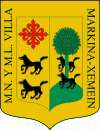Markina-Xemein
 |
The local economy is mostly based on the primary and secondary sectors, with particular relevance for agriculture and cattle herding, timber research and metal industry. The metal industry has in fact played an important role in the past, through the development of important weapons in the defense industry. Extraction of black marble, known as Nero Marquina (Marmol Negro), also plays an important role in the local economy. The high quality of the stone has gained international recognition; it is one of the most important marbles from Spain.
Markina-Xemein keeps a tight connection with Basque pelota sport; in fact its two walled court or frontón is known as "University of the Pelota", since it is the place where great Basket or Jai Alai pelotaris learnt to play.
Markina-Xemein's patron saint festival, consecrated to the Virgen del Carmen, takes place in the middle of July. Besides, the municipality hosts many fairs and markets all through the year.
Markina-Xemein is located in the north east of Biscay, and it is next to the border with Gipuzkoa. Although the village centre is plain, it is surrounded by hills and mountains, most of them 400 to 700 metres high. Oiz, located to the southwest, is 1,026 metres high.
The main river is Artibai, which passes through Markina-Xemein from southwest to northeast. Near the village centre, it is joined by another river from the southeast, Urko.
Markina-Xemein enjoys a mild climate throughout the year, thanks to being located only 10 kilometers from the coast. Winters tend to be a little bit cool and wet, but not snowy. Although summers are relatively hot, temperatures hardly ever go above 35° Celsius. Apart from that, all the seasons are wet and rainy, so yearly rainfall is above 1550 mm.
Map - Markina-Xemein
Map
Country - Spain
 |
 |
| Flag of Spain | |
Anatomically modern humans first arrived in the Iberian Peninsula around 42,000 years ago. The ancient Iberian and Celtic tribes, along with other pre-Roman peoples, dwelled the territory maintaining contacts with foreign Mediterranean cultures. The Roman conquest and colonization of the peninsula (Hispania) ensued, bringing the Romanization of the population. Receding of Western Roman imperial authority ushered in the migration of different non-Roman peoples from Central and Northern Europe with the Visigoths as the dominant power in the peninsula by the fifth century. In the early eighth century, most of the peninsula was conquered by the Umayyad Caliphate, and during early Islamic rule, Al-Andalus became a dominant peninsular power centered in Córdoba. Several Christian kingdoms emerged in Northern Iberia, chief among them León, Castile, Aragon, Portugal, and Navarre made an intermittent southward military expansion, known as Reconquista, repelling the Islamic rule in Iberia, which culminated with the Christian seizure of the Emirate of Granada in 1492. Jews and Muslims were forced to choose between conversion to Catholicism or expulsion, and eventually the converts were expelled through different royal decrees.
Currency / Language
| ISO | Currency | Symbol | Significant figures |
|---|---|---|---|
| EUR | Euro | € | 2 |
| ISO | Language |
|---|---|
| EU | Basque language |
| CA | Catalan language |
| GL | Galician language |
| OC | Occitan language |
| ES | Spanish language |
















